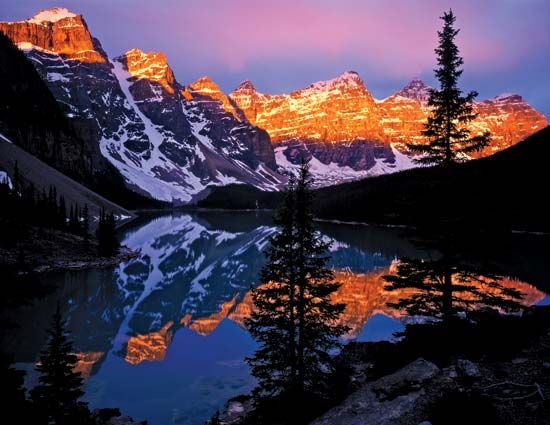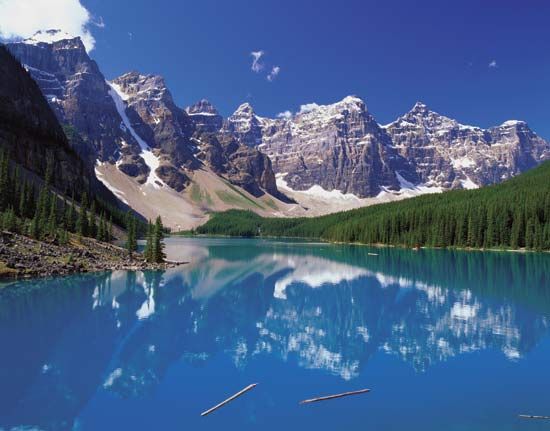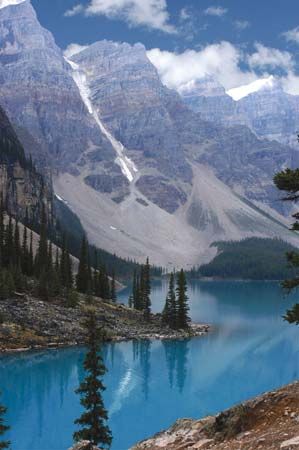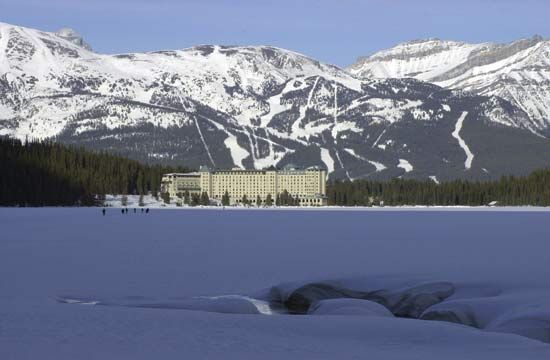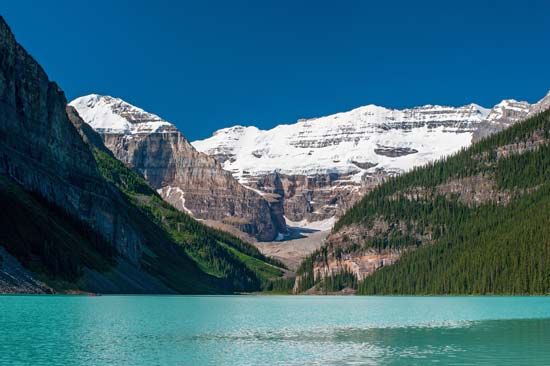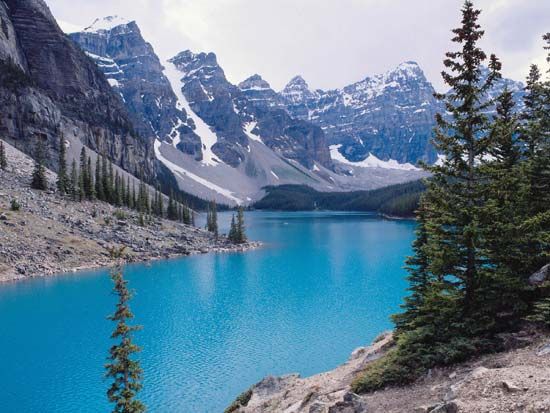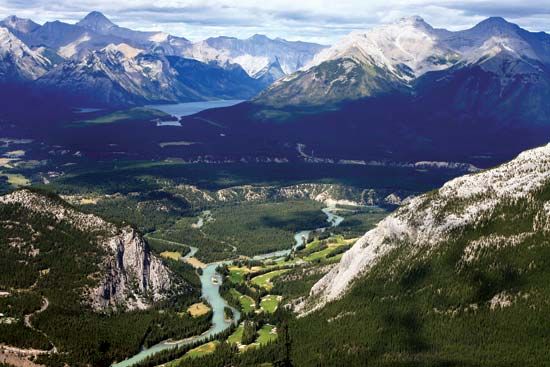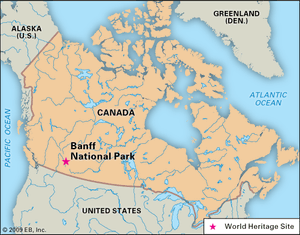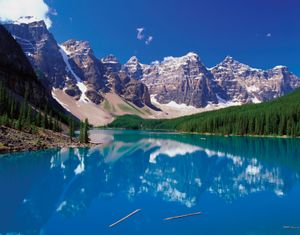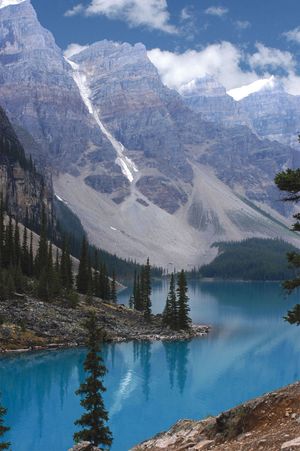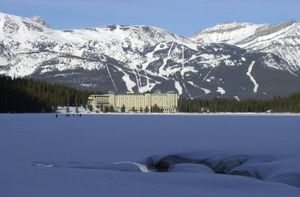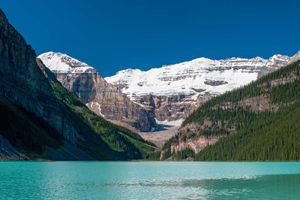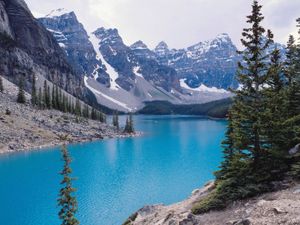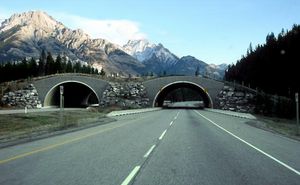Banff National Park
- In full:
- Banff National Park of Canada
Banff National Park, scenic natural and wilderness area in southwestern Alberta, Canada. Established as a national park in 1887, it occupies 2,564 square miles (6,641 square km) along the eastern slopes of the Rocky Mountains and abuts the border with British Columbia. Yoho and Kootenay national parks are adjacent to Banff in British Columbia, and Jasper National Park in Alberta lies to the northwest of Banff. Much of the rest of the land surrounding the park is within provincial parks or other protected areas. Park headquarters are in the town of Banff in the southern part of the park, about 80 miles (130 km) west of Calgary. Noted for its beauty, plant and animal diversity, and ongoing geologic processes, Banff National Park was designated part of the Canadian Rocky Mountain Parks UNESCO World Heritage site in 1984.
Natural history
Banff National Park trends northwest to southeast along the line of the Canadian Rockies between Alberta and British Columbia. Its terrain is largely rugged and mountainous, a sizable portion of it consisting of high alpine peaks of the Main Ranges section of the Rockies, particularly in its western section along the Continental Divide. Most of the rest of the land is designated as subalpine or montane landscape and lies in the Front Ranges. The mountains in the region are composed of limestone, shale, and other sedimentary rocks and have a toothlike appearance as the result of glaciation. Many peaks rise above 10,000 feet (3,050 metres), including Mount Columbia on the park’s western border in the Ten Peaks region, which reaches 11,365 feet (3,464 metres), and Mount Sir Douglas in the far southeast, with an elevation of 11,175 feet (3,406 metres). Banff contains active glaciers, including a portion of the extensive Columbia Icefield to the north, and montane wetlands and meadows, such as the valleys of the Bow and Red Deer rivers. The park is also noted for its beautiful alpine lakes, particularly Lake Louise, stretching northeastward from Mount Columbia, and, a short distance to the south, Moraine Lake.
The region has a cool montane climate that varies considerably with location and elevation. Summers are moderately warm, with daytime highs in July and August of about 72 °F (22 °C) at the town of Banff and frequent afternoon thundershowers. Winters are long, snowy, and cold, with nighttime lows reaching about 5 °F (−15 °C) in January; periodic cold snaps can send temperatures much lower. Snow generally falls from late September to May, with total seasonal accumulations of some 10 feet (3 metres).

Tree species of the lower-elevation montane region include Douglas firs, lodgepole pines, aspen, and, less commonly, black spruce. Englemann spruce, limber pines, and other conifers grow in the lower elevations of the subalpine region, with patches of hardier vegetation such as low-growing willows higher up. The alpine zone above the timberline (about 7,550 feet [2,300 metres]) supports mosses, lichens, and some low shrubs in its lower reaches, but much of the terrain there consists of bare rock and ice. A large variety of wildflowers proliferate throughout the zones, most blooming in July and August.
The park is home to several dozen mammal species, among them brown (grizzly) and black bears, elk (wapiti), moose, mule deer, wolves and coyotes, pumas (cougars), bighorn sheep and mountain goats, and a large number of smaller mammals including pikas, wolverines, and marmots and other rodents. Birdlife is abundant, with more than 260 species known to live in the park or to migrate to or through it seasonally. Among the most numerous are swallows, waterfowl (ducks, Canada geese, and teals), and a great variety of songbirds. The park’s lakes and streams have large fish populations, notably of trout, whitefish, and salmon.
The human imprint
People have lived in the Banff region for nearly 11,000 years. In 1883 employees of the Canadian Pacific Railway discovered a cluster of natural hot springs above the Bow River valley, a narrow montane ecoregion that runs through the heart of what is now Banff National Park. Squabbles over ownership of the springs led the Canadian government in 1885 to declare a 10-square-mile (26-square-km) area around the springs a natural reserve. Two years later the region became Canada’s first national park under the Rocky Mountains Park Act. In 1930 the park was extended to 2,585 square miles (6,695 square km) and given its present name, and in 1949 the park was slightly reduced in area to its present size.
With some three to four million visitors each year, Banff is Canada’s most popular national park and an internationally renowned alpine sports location. It is easily accessible via the Trans-Canada Highway from Calgary (the highway continues westward through the park) or from other roads that enter the park from the north, east, and southwest. There are numerous campgrounds and trailer sites in or near the park, as well as guest accommodations at Banff town and at another community in the park, Lake Louise (at the northeast end of the lake), and in towns outside the park (notably Canmore, southeast of Banff). In addition to hundreds of miles of hiking trails in the park and winter sports venues at Banff and Lake Louise, a variety of other recreational activities are available for visitors. The park maintains museums in Banff town and information centres at several locations. There are hundreds of archaeological sites in the park, including at Vermilion Lakes, at which some of Canada’s earliest known human remains have been discovered.
For some time, park officials and others have been concerned that the large human presence in the park has had an adverse effect on wildlife and fish habitats, animal migration, and water quality. In addition to the park’s many visitors, thousands more travelers traverse it daily on the Trans-Canada Highway, and trains pass through it on the Canadian Pacific tracks, a major east-west rail link for the country. There are also concerns about the effects of climate change on the park’s ecosystem, as gradually warmer temperatures in the region are thought to be contributing to the shrinking of glaciers and ice fields and also allowing for an increase in plant pests such as white pine blister rust and mountain pine beetles that attack and kill conifers.
Kenneth Pletcher
